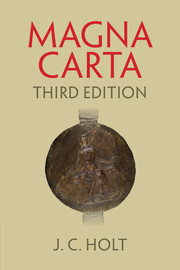Book contents
- Frontmatter
- Dedication
- Contents
- List of plates
- Preface to third edition
- Preface to second edition
- Preface to first edition
- Acknowledgements
- Abbreviations
- Introduction
- 1 The Charter and its history
- 2 Government and society in the twelfth century
- 3 Privilege and liberties
- 4 Custom and law
- 5 Justice and jurisdiction
- 6 Crisis and civil war
- 7 Quasi Pax
- 8 The quality of the Great Charter
- 9 The achievement of 1215
- 10 From distraint to war
- 11 The re-issues and the beginning of the myth
- Appendices
- 1 The meeting at Bury St Edmunds, 1214
- 2 Notification of Thomas count of Perche, February 1215
- 3 Triplex forma pacis
- 4 The ‘unknown’ charter
- 5 The Articles of the Barons
- 6 Magna Carta, 1215
- 7 Translations of the Charters
- 8 The Twenty-Five barons of Magna Carta, 1215
- 9 The date of the London treaty
- 10 The Oxford Council, 16–23 July 1215
- 11 Select documents illustrative of the history of Magna Carta, 1215
- 12 Magna Carta, 1225
- 13 Charter of the Forest, 1225
- 14 Liberties and perpetuity
- References
- Index
- Plate section
7 - Translations of the Charters
from Appendices
Published online by Cambridge University Press: 05 July 2015
- Frontmatter
- Dedication
- Contents
- List of plates
- Preface to third edition
- Preface to second edition
- Preface to first edition
- Acknowledgements
- Abbreviations
- Introduction
- 1 The Charter and its history
- 2 Government and society in the twelfth century
- 3 Privilege and liberties
- 4 Custom and law
- 5 Justice and jurisdiction
- 6 Crisis and civil war
- 7 Quasi Pax
- 8 The quality of the Great Charter
- 9 The achievement of 1215
- 10 From distraint to war
- 11 The re-issues and the beginning of the myth
- Appendices
- 1 The meeting at Bury St Edmunds, 1214
- 2 Notification of Thomas count of Perche, February 1215
- 3 Triplex forma pacis
- 4 The ‘unknown’ charter
- 5 The Articles of the Barons
- 6 Magna Carta, 1215
- 7 Translations of the Charters
- 8 The Twenty-Five barons of Magna Carta, 1215
- 9 The date of the London treaty
- 10 The Oxford Council, 16–23 July 1215
- 11 Select documents illustrative of the history of Magna Carta, 1215
- 12 Magna Carta, 1225
- 13 Charter of the Forest, 1225
- 14 Liberties and perpetuity
- References
- Index
- Plate section
Summary
A surprising number of the documents of 1215 survive in Anglo-Norman translations. These include the Charter itself, the writ of 27 June directed to the sheriffs and twelve elected knights of each county authorizing them to distrain on those who refused the oath to the Twenty-Five, and versions of the charters of liberties of Henry I, Stephen and Henry II. The first two are included in the cartulary of the leper Hospital of St. Giles at Pont- Audemer, Normandy (Rouen, Bibliothèque Municipale, MS y 200). The charters of liberties constitute Harleian MS 458 in the British Library.
The first two were published under the title of ‘A vernacular-French text of Magna Carta, 1215’. It is now clear that they are in fact in Anglo- Norman. The writ, unlike the enrolled version on the Patent roll, was addressed to the sheriff of Hampshire. It is therefore reasonable to suppose that this vernacular version of the charter was intended for proclamation in the county court of Hampshire in 1215. If so, it lies at or near the origin of the public proclamation of the charters and other documents in both French and English, which was certainly being practised by the 1250s. That leaves some obvious questions – were there other translations? Where and how were they made? To these the Harleian MS suggests some possible answers.
Harleian MS 458 is only a bifolium. Liebermann used it in his work on the text of the charter of Henry I, but he did not appreciate its importance and misdated the translations on the second folio. It has escaped attention since. It is written in a careful, indeed handsome, business hand, or probably more than one. These are not scrappy notes or hasty transcripts but texts clearly and spaciously arranged. Nothing is known of its history except that it passed through the hands of the antiquary Peter Le Neve in the late seventeenth, or early eighteenth, century. It may be significant that Le Neve did much work on the records in the Rolls Chapel.
- Type
- Chapter
- Information
- Magna Carta , pp. 399 - 401Publisher: Cambridge University PressPrint publication year: 2015



